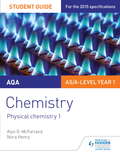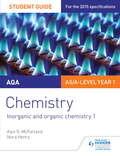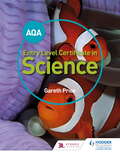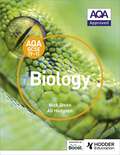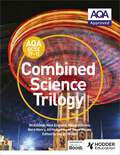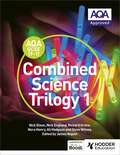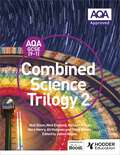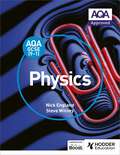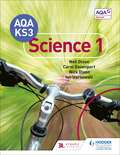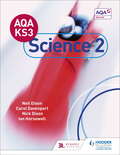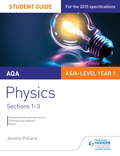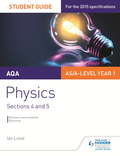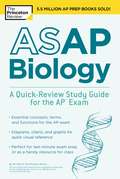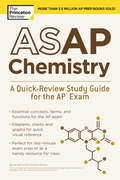- Table View
- List View
AQA Chemistry Student Guide 1: Physical chemistry 1
by Nora Henry Alyn G. McfarlandWritten by experienced examiners Alyn McFarland and Nora Henry, this Student Guide for Chemistry:- Helps you identify what you need to know with a concise summary of the topics examined in the AS and A-level specifications- Consolidates understanding with tips and knowledge check questions- Provides opportunities to improve exam technique with sample answers to exam-style questions- Develops independent learning and research skills- Provides the content for generating individual revision notes
AQA Chemistry Student Guide 2: Inorganic and organic chemistry
by Nora Henry Alyn G. McfarlandWritten by experienced examiners Alyn McFarland and Nora Henry, this Student Guide for Chemistry:- Helps you identify what you need to know with a concise summary of the topics examined in the AS and A-level specifications- Consolidates understanding with tips and knowledge check questions- Provides opportunities to improve exam technique with sample answers to exam-style questions- Develops independent learning and research skills- Provides the content for generating individual revision notes
AQA Entry Level Certificate in Science Student Book
by Gareth PriceInspire students to progress with this fresh and contemporary take on Science, brought to life through clear explanations and real-world examples that are tailored to the new AQA Entry Level Certificate in Science specification requirements.- Provides you with a very different sort of textbook to help engage students who are disillusioned or struggling with their science study; full of relevant contexts, exciting photographs and a sense of fun.- Offers activities that will demonstrate students' understanding in a variety of ways, from factual recall and enquiry skills, to group discussion and creative/artistic tasks.- Created to support students with lower literacy levels.- Provides comprehensive support for non-specialist or less-confident teachers when used in conjunction with the online Teaching & Learning resources.- Offers flexibility to use with either Entry Level students or as a support resources for Foundation-tier GCSE Combined Science candidates.
AQA Entry Level Certificate in Science Student Book
by Gareth PriceExam Board: AQALevel: KS3Subject: ScienceFirst Teaching: September 2016First Exam: June 2017Inspire students to progress with this fresh and contemporary take on Science, brought to life through clear explanations and real-world examples that are tailored to the new AQA Entry Level Certificate in Science specification requirements.- Provides you with a very different sort of textbook to help engage students who are disillusioned or struggling with their science study; full of relevant contexts, exciting photographs and a sense of fun.- Offers activities that will demonstrate students' understanding in a variety of ways, from factual recall and enquiry skills, to group discussion and creative/artistic tasks.- Created to support students with lower literacy levels.- Provides comprehensive support for non-specialist or less-confident teachers when used in conjunction with the online Teaching & Learning resources.- Offers flexibility to use with either Entry Level students or as a support resources for Foundation-tier GCSE Combined Science candidates.
AQA GCSE (9-1) Biology Student Book
by Nick Dixon Ali HodgsonExam Board: AQALevel: GCSESubject: BiologyFirst Teaching: September 2016First Exam: June 2018AQA approved.Develop your students' scientific thinking and practical skills within a more rigorous curriculum; differentiated practice questions, progress tracking, mathematical support and assessment preparation will consolidate understanding and develop key skills to ensure progression.- Builds scientific thinking, analysis and evaluation skills with dedicated Working Scientifically tasks and support for the 8 required practicals, along with extra activities for broader learning- Supports students of all abilities with plenty of scaffolded and differentiated Test Yourself Questions, Show You Can challenges, Chapter review Questions and synoptic practice Questions- Supports Foundation and Higher tier students, with Higher tier-only content clearly marked- Builds Literacy skills for the new specification with key words highlighted and practice extended answer writing and spelling/vocabulary testsFREE GCSE SCIENCE TEACHER GUIDESThese will be provided for free via our website. To request your free copies please email science@hodder.co.uk
AQA GCSE (9-1) Biology Student Book
by Nick Dixon Ali HodgsonExam Board: AQALevel: GCSESubject: BiologyFirst Teaching: September 2016First Exam: June 2018AQA approved.Develop your students' scientific thinking and practical skills within a more rigorous curriculum; differentiated practice questions, progress tracking, mathematical support and assessment preparation will consolidate understanding and develop key skills to ensure progression.- Builds scientific thinking, analysis and evaluation skills with dedicated Working Scientifically tasks and support for the 8 required practicals, along with extra activities for broader learning- Supports students of all abilities with plenty of scaffolded and differentiated Test Yourself Questions, Show You Can challenges, Chapter review Questions and synoptic practice Questions- Supports Foundation and Higher tier students, with Higher tier-only content clearly marked- Builds Literacy skills for the new specification with key words highlighted and practice extended answer writing and spelling/vocabulary testsFREE GCSE SCIENCE TEACHER GUIDESThese will be provided for free via our website. To request your free copies please email science@hodder.co.uk
AQA GCSE (9-1) Chemistry Student Book
by Nora Henry Richard GrimeExam Board: AQALevel: GCSESubject: ChemistryFirst Teaching: September 2016First Exam: June 2018AQA approved.Expand and challenge your students' knowledge and understanding of Chemistry with this textbook that guides students through each topic, the 8 required practical activities and assessment requirements of the new 2016 AQA GCSE Chemistry specification.- Provides support for all 8 required practicals, along with extra tasks for broader learning- Tests understanding and consolidate learning with Test Yourself questions, Show you Can challenges, Chapter review questions and synoptic practice questions- Supports Foundation and Higher tier students, with Higher tier-only content clearly marked- Builds Literacy skills for the new specification with key words highlighted and practice extended answer writing and spelling/vocabulary testsFREE GCSE SCIENCE TEACHER GUIDESThese will be provided for free via our website. To request your free copies please email science@hodder.co.uk
AQA GCSE (9-1) Chemistry Student Book
by Nora Henry Richard GrimeExam Board: AQALevel: GCSESubject: ChemistryFirst Teaching: September 2016First Exam: June 2018AQA approved.Expand and challenge your students' knowledge and understanding of Chemistry with this textbook that guides students through each topic, the 8 required practical activities and assessment requirements of the new 2016 AQA GCSE Chemistry specification.- Provides support for all 8 required practicals, along with extra tasks for broader learning- Tests understanding and consolidate learning with Test Yourself questions, Show you Can challenges, Chapter review questions and synoptic practice questions- Supports Foundation and Higher tier students, with Higher tier-only content clearly marked- Builds Literacy skills for the new specification with key words highlighted and practice extended answer writing and spelling/vocabulary testsFREE GCSE SCIENCE TEACHER GUIDESThese will be provided for free via our website. To request your free copies please email science@hodder.co.uk
AQA GCSE (9-1) Combined Science Trilogy Student Book
by Nick England Nora Henry Nick Dixon Richard Grime Steve Witney Ali HodgsonExam Board: AQALevel: GCSESubject: ScienceFirst Teaching: September 2016First Exam: June 2018AQA ApprovedBuild your students' scientific thinking, analysis and evaluation with this textbook that leads them seamlessly from basic concepts to more complicated theories, with topical examples, practical activities and mathematical support throughout.- Developed specifically for the 2016 AQA GCSE Combined Science Trilogy specification.-Builds experimental, analytical and evaluation skills with activities that introduce the 16 required practicals, along with extra Working Scientifically tasks for broader learning-Provides plenty of opportunity for students to apply their knowledge and understanding with Test Yourself questions, Show You Can challenges, Chapter review questions and synoptic practice questions-Supports Foundation and Higher tier students in one book, with Higher tier-only content clearly marked.This book covers the topics in Biology Paper 1, Chemistry Paper 1, Physics Paper 1, Biology Paper 2, Chemistry Paper 2 and Physics Paper 2FREE GCSE SCIENCE TEACHER GUIDESThese will be provided for free via our website. To request your free copies please email science@hodder.co.uk
AQA GCSE (9-1) Combined Science Trilogy Student Book 1
by Nick England Nora Henry Nick Dixon Richard Grime Steve Witney Ali HodgsonExam Board: AQALevel: GCSESubject: ScienceFirst Teaching: September 2016First Exam: June 2018AQA approved.Build your students' scientific thinking, analysis and evaluation with this textbook that leads them seamlessly from basic concepts to more complicated theories, with topical examples, practical activities and mathematical support throughout.Developed specifically for the 2016 AQA GCSE Combined Science Trilogy specification.-Builds experimental, analytical and evaluation skills with activities that introduce the 16 required practicals, along with extra Working Scientifically tasks for broader learning-Provides plenty of opportunity for students to apply their knowledge and understanding with Test Yourself questions, Show You Can challenges, Chapter review questions and synoptic practice questions-Supports Foundation and Higher tier students in one book, with Higher tier-only content clearly marked.Book 1 covers the topics in Biology Paper 1, Chemistry Paper 1 and Physics Paper 1FREE GCSE SCIENCE TEACHER GUIDESThese will be provided for free via our website. Biology will be available in OctoberChemistry will be available in JanuaryPhysics will be available in MarchTo request your free copies please email science@hodder.co.uk
AQA GCSE (9-1) Combined Science Trilogy Student Book 1
by Nick England Nora Henry Nick Dixon Richard Grime Steve Witney Ali HodgsonExam Board: AQALevel: GCSESubject: ScienceFirst Teaching: September 2016First Exam: June 2018AQA approved.Build your students' scientific thinking, analysis and evaluation with this textbook that leads them seamlessly from basic concepts to more complicated theories, with topical examples, practical activities and mathematical support throughout.Developed specifically for the 2016 AQA GCSE Combined Science Trilogy specification.-Builds experimental, analytical and evaluation skills with activities that introduce the 16 required practicals, along with extra Working Scientifically tasks for broader learning-Provides plenty of opportunity for students to apply their knowledge and understanding with Test Yourself questions, Show You Can challenges, Chapter review questions and synoptic practice questions-Supports Foundation and Higher tier students in one book, with Higher tier-only content clearly marked.Book 1 covers the topics in Biology Paper 1, Chemistry Paper 1 and Physics Paper 1FREE GCSE SCIENCE TEACHER GUIDESThese will be provided for free via our website. Biology will be available in OctoberChemistry will be available in JanuaryPhysics will be available in MarchTo request your free copies please email science@hodder.co.uk
AQA GCSE (9-1) Combined Science Trilogy Student Book 2
by Nick England Nora Henry Nick Dixon Richard Grime Steve Witney Ali HodgsonExam Board: AQALevel: GCSESubject: ScienceFirst Teaching: September 2016First Exam: June 2018AQA approved.Build your students' scientific thinking, analysis and evaluation with this textbook that leads them seamlessly from basic concepts to more complicated theories, with topical examples, practical activities and mathematical support throughout.Developed specifically for the 2016 AQA GCSE Combined Science Trilogy specification.-Builds experimental, analytical and evaluation skills with activities that introduce the 16 required practicals, along with extra Working Scientifically tasks for broader learning-Provides plenty of opportunity for students to apply their knowledge and understanding with Test Yourself questions, Show You Can challenges, Chapter review questions and synoptic practice questions-Supports Foundation and Higher tier students in one book, with Higher tier-only content clearly marked.Book 2 covers the topics in Biology Paper 2, Chemistry Paper 2 and Physics Paper 2FREE GCSE SCIENCE TEACHER GUIDESThese will be provided for free via our website. Biology will be available in OctoberChemistry will be available in JanuaryPhysics will be available in MarchTo request your free copies please email science@hodder.co.uk
AQA GCSE (9-1) Combined Science Trilogy Student Book 2
by Nick England Nora Henry Nick Dixon Richard Grime Steve Witney Ali HodgsonExam Board: AQALevel: GCSESubject: ScienceFirst Teaching: September 2016First Exam: June 2018AQA approved.Build your students' scientific thinking, analysis and evaluation with this textbook that leads them seamlessly from basic concepts to more complicated theories, with topical examples, practical activities and mathematical support throughout.Developed specifically for the 2016 AQA GCSE Combined Science Trilogy specification.-Builds experimental, analytical and evaluation skills with activities that introduce the 16 required practicals, along with extra Working Scientifically tasks for broader learning-Provides plenty of opportunity for students to apply their knowledge and understanding with Test Yourself questions, Show You Can challenges, Chapter review questions and synoptic practice questions-Supports Foundation and Higher tier students in one book, with Higher tier-only content clearly marked.Book 2 covers the topics in Biology Paper 2, Chemistry Paper 2 and Physics Paper 2FREE GCSE SCIENCE TEACHER GUIDESThese will be provided for free via our website. Biology will be available in OctoberChemistry will be available in JanuaryPhysics will be available in MarchTo request your free copies please email science@hodder.co.uk
AQA GCSE (9-1) Physics Student Book
by Nick England Steve WitneyExam Board: AQALevel: GCSESubject: PhysicsFirst Teaching: September 2016First Exam: June 2018AQA approved.Apply and develop your students' knowledge and understanding of Physics with this textbook that builds mathematical skills, provides practical assessment guidance and supports all the required practicals.- Provides support for all the required practicals with activities that introduce practical work and other experimental investigations in Physics- Builds understanding and knowledge with a variety of questions to engage and challenge: Test Yourself questions, Show You Can challenges, Chapter review questions and synoptic practice questions- Supports Foundation and Higher tier students in one book, with Higher tier-only content clearly marked- Builds Literacy skills for the new specification with key words highlighted and practice extended answer writing and spelling/vocabulary testsFREE GCSE SCIENCE TEACHER GUIDESThese will be provided for free via our website. To request your free copies please email science@hodder.co.uk
AQA Key Stage 3 Science Pupil Book 1
by Nick Dixon Neil Dixon Carol DavenportEnsure that every student develops the maths, literacy and working scientifically skills they need to succeed with this skills-focused Pupil Book that contains a variety of activities, questions and real-world examples that are tailored to the Big Ideas and mastery goals of the AQA KS3 Syllabus. - Develop conceptual understanding with a variety of questions that require students to apply their knowledge to real-world scenarios.- Build working scientifically skills with various Enquiry activities matched to the AQA syllabus.- Test understanding and measure progress with factual recall questions developed around the ideas of Generalisations, Principles and Models.- Stretch knowledge and understanding with extend tasks linked to higher-order thinking skills - Compare, Evaluate and Predict.- Bridge the gap between Key Stages 2 and 3, with a focus on maths and enquiry skills and understanding scientific terminology.- Provides comprehensive support for non-specialist or less-confident teachers when used in conjunction with the online Teaching & Learning resources.Written in association with Sheffield Hallam University:The Science Education Team within Sheffield Institute of Education (SIoE), is one of the leading STEM education groups in Europe, with a worldwide reputation for knowledge exchange and research. SIoE leads national and international STEM education programmes covering curriculum and pedagogical design and development, widening participation to traditionally under-represented groups, and research in science education.
AQA Key Stage 3 Science Pupil Book 1
by Nick Dixon Neil Dixon Carol Davenport Ian HorsewellEnsure that every student develops the maths, literacy and working scientifically skills they need to succeed with this skills-focused Pupil Book that contains a variety of activities, questions and real-world examples that are tailored to the Big Ideas and mastery goals of the AQA KS3 Syllabus. - Develop conceptual understanding with a variety of questions that require students to apply their knowledge to real-world scenarios.- Build working scientifically skills with various Enquiry activities matched to the AQA syllabus.- Test understanding and measure progress with factual recall questions developed around the ideas of Generalisations, Principles and Models.- Stretch knowledge and understanding with extend tasks linked to higher-order thinking skills - Compare, Evaluate and Predict.- Bridge the gap between Key Stages 2 and 3, with a focus on maths and enquiry skills and understanding scientific terminology.- Provides comprehensive support for non-specialist or less-confident teachers when used in conjunction with the online Teaching & Learning resources.Written in association with Sheffield Hallam University:The Science Education Team within Sheffield Institute of Education (SIoE), is one of the leading STEM education groups in Europe, with a worldwide reputation for knowledge exchange and research. SIoE leads national and international STEM education programmes covering curriculum and pedagogical design and development, widening participation to traditionally under-represented groups, and research in science education.
AQA Key Stage 3 Science Pupil Book 2
by Nick Dixon Neil Dixon Carol DavenportEnsure that every student develops the maths, literacy and working scientifically skills they need to succeed with this skills-focused Pupil Book that contains a variety of activities, questions and real-world examples that are tailored to the Big Ideas and mastery goals of the AQA KS3 Syllabus. - Develop conceptual understanding with a variety of questions that require students to apply their knowledge to real-world scenarios.- Build working scientifically skills with various Enquiry activities matched to the AQA syllabus.- Test understanding and measure progress with factual recall questions developed around the ideas of Generalisations, Principles and Models.- Stretch knowledge and understanding with extend tasks linked to higher-order thinking skills - Compare, Evaluate and Predict.- Bridge the gap between Key Stages 2 and 3, with a focus on maths and enquiry skills and understanding scientific terminology.- Provides comprehensive support for non-specialist or less-confident teachers when used in conjunction with the online Teaching & Learning resources.Written in association with Sheffield Hallam University:The Science Education Team within Sheffield Institute of Education (SIoE), is one of the leading STEM education groups in Europe, with a worldwide reputation for knowledge exchange and research. SIoE leads national and international STEM education programmes covering curriculum and pedagogical design and development, widening participation to traditionally under-represented groups, and research in science education.
AQA Key Stage 3 Science Pupil Book 2
by Nick Dixon Neil Dixon Carol Davenport Ian HorsewellEnsure that every student develops the maths, literacy and working scientifically skills they need to succeed with this skills-focused Pupil Book that contains a variety of activities, questions and real-world examples that are tailored to the Big Ideas and mastery goals of the AQA KS3 Syllabus. - Develop conceptual understanding with a variety of questions that require students to apply their knowledge to real-world scenarios.- Build working scientifically skills with various Enquiry activities matched to the AQA syllabus.- Test understanding and measure progress with factual recall questions developed around the ideas of Generalisations, Principles and Models.- Stretch knowledge and understanding with extend tasks linked to higher-order thinking skills - Compare, Evaluate and Predict.- Bridge the gap between Key Stages 2 and 3, with a focus on maths and enquiry skills and understanding scientific terminology.- Provides comprehensive support for non-specialist or less-confident teachers when used in conjunction with the online Teaching & Learning resources.Written in association with Sheffield Hallam University:The Science Education Team within Sheffield Institute of Education (SIoE), is one of the leading STEM education groups in Europe, with a worldwide reputation for knowledge exchange and research. SIoE leads national and international STEM education programmes covering curriculum and pedagogical design and development, widening participation to traditionally under-represented groups, and research in science education.
AQA Physics Student Guide 1: Sections 1-3
by Jeremy PollardWritten by experienced author Jeremy Pollard, this Student Guide for Physics:- Helps you identify what you need to know with a concise summary of the topics examined in the AS and A-level specifications- Consolidates understanding with tips and knowledge check questions- Provides opportunities to improve exam technique with sample answers to exam-style questions- Develops independent learning and research skills- Provides the content for generating individual revision notes
AQA Physics Student Guide 2: Sections 4 and 5
by Ian LovatWritten by experienced teacher Ian Lovat, this Student Guide for Physics:- Helps you identify what you need to know with a concise summary of the topics examined in the AS and A-level specifications- Consolidates understanding with tips and knowledge check questions- Provides opportunities to improve exam technique with sample answers to exam-style questions- Develops independent learning and research skills- Provides the content for generating individual revision notes
ARMIX sukaldean: Mugaritzen laguntzarekin
by Elhuyar Fundazioa ElhuyarHaurrentzako zientzia liburua
ARQUIVO ROJAS NASA REPORTS 1/2/3
by Pierre MonteagudoEsta é a história de uma criança prodígio chamado Hector Rafael que, com base em sua vontade de ferro, se tornou um astrofísico da NASA e um cientista chave na chegada do homem à Lua.
ASAP Biology: A Quick-Review Study Guide for the AP Exam
by Princeton ReviewLIKE CLASS NOTES—ONLY BETTER. The Princeton Review's ASAP Biology is designed to help you zero in on just the information you need to know to successfully grapple with the AP test. Advanced Placement exams require students to have a firm grasp of content—you can't bluff or even logic your way to a 5. Like a set of class notes borrowed from the smartest student in your grade, this book gives you exactly that. No tricks or crazy stratagems, no sample essays or practice sets: Just the facts, presented with lots of helpful visuals. Inside ASAP Biology, you'll find:• Essential concepts, terms, and functions for AP Biology—all explained clearly & concisely• Diagrams, charts, lists, and graphs for quick visual reference• A three-pass icon system designed to help you prioritize learning what you MUST, SHOULD, and COULD know in the time you have available• "Ask Yourself" questions to help identify areas where you might need extra attention• A resource that's perfect for last-minute exam prep and for daily class workTopics covered in ASAP Biology include:• The chemistry of life• Evolutionary biology• Cells & cellular energetics• Heredity & molecular genetics• Animal structure & function• Behavior & ecology• Quantitative skills & biostatistics... and more!Looking for sample exams, practice questions, and test-taking strategies? Check out our extended, in-depth AP Biology prep guide, Cracking the AP Biology Exam!
ASAP Chemistry: A Quick-Review Study Guide for the AP Exam (College Test Preparation)
by Princeton ReviewLIKE CLASS NOTES—ONLY BETTER. The Princeton Review's ASAP Chemistry is designed to help you zero in on just the information you need to know to successfully grapple with the AP test. Advanced Placement exams require students to have a firm grasp of content—you can't bluff or even logic your way to a 5. Like a set of class notes borrowed from the smartest student in your grade, this book gives you exactly that. No tricks or crazy stratagems, no sample essays or practice sets: Just the facts, presented with lots of helpful visuals. Inside ASAP Chemistry, you'll find:• Essential concepts, terms, and functions for AP Chem—all explained clearly & concisely• Diagrams, charts, and graphs for quick visual reference• A three-pass icon system designed to help you prioritize learning what you MUST, SHOULD, and COULD know in the time you have available• "Ask Yourself" questions to help identify areas where you might need extra attention• A resource that's perfect for last-minute exam prep and for daily class workTopics covered in ASAP Chemistry include:• Atomic structure• Covalent bonding & intermolecular forces• Thermochemistry• Acids & bases... and more!Looking for sample exams, practice questions, and test-taking strategies? Check out our extended, in-depth AP chem prep guide, Cracking the AP Chemistry Exam!
